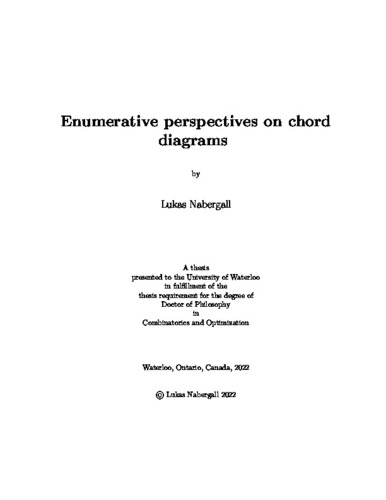| dc.description.abstract | The topic of this thesis is enumerating certain classes of chord diagrams, perfect matchings of the interval $\{1, 2, \ldots, 2n\}$. We consider hereditary classes of chord diagrams that are restricted to satisfy one of several connectedness properties: connectivity, 1-terminality, and 1-sym-terminality (in order of increasing restrictedness). Such classes are defined by a set of minimal forbidden subdiagrams or patterns, and we focus on forbidding graphically-defined subdiagrams, in particular those whose intersection graph is isomorphic to a cycle. There are exactly two cycle diagrams of size $n$: the top cycle $T_{n}$ and bottom cycle $B_{n}$. The class $\mc{D}(T_{\geqslant 3})$ of diagrams avoiding a top cycle of size three or greater was previously shown to be equinumerous with the class of $\includesvg[scale=.34]{graphics/D_213.svg}$-free diagrams by Jel\'{i}nek, while the connected version of this class was put in bijection with planar bridgeless combinatorial maps by Courtiel, Yeats, and Zeilberger.
We begin by extending the recently developed automated enumeration framework Combinatorial Exploration of Albert, Baen, Claesson, Nadeau, Pantone, and Ulfarsson for enumerating combinatorial classes to chord diagrams. This framework algorithmically searches for a combinatorial specification for a given class by decomposing the class using a fixed set of decomposition strategies. Building off of their work, we construct a geometric version of chord diagrams amenable to Combinatorial Exploration and then describe a series of decomposition strategies for these geometric chord diagram classes. Most of these strategies are based on those developed for permutation classes by Albert, Baen, Claesson, Nadeau, Pantone, and Ulfarsson, but several appear to be new.
We then manually apply this framework to successfully enumerate a handful of diagram classes, including $\mc{C}(\includesvg[scale=.34]{graphics/D_123.svg}, \includesvg[scale=.34]{graphics/D_132.svg})$, $\mc{C}(T_{\geqslant 3}, B_{\geqslant 3})$, $\mc{D}(\includesvg[scale=.34]{graphics/D_123.svg}, \includesvg[scale=.34]{graphics/D_132.svg}, \includesvg[scale=.34]{graphics/D_213.svg})$, $\mc{C}(B_{\geqslant 3})$, and $\mc{T}(B_{\geqslant 3})$. All but the second class have not previously been enumerated, and we give explicit closed-form formulas for each of them. As a corollary it follows that the number $|\mc{C}_{n+1}(B_{\geqslant 3})|$ of bottom-cycle-free diagrams of size $n+1$ is equal to $|\mc{D}_{n}(\includesvg[scale=.34]{graphics/D_123.svg}, \includesvg[scale=.34]{graphics/D_132.svg})|$, while $|\mc{C}_{n+1}(T_{\geqslant 3}, B_{\geqslant 3})| = |\mc{D}_{n}(\includesvg[scale=.34]{graphics/D_123.svg}, \includesvg[scale=.34]{graphics/D_132.svg}, \includesvg[scale=.34]{graphics/D_213.svg})|$. This appears to be a universal offset phenomenon---where connected classes are enumeratively equivalent to not-necessarily connected classes, the counting sequences are offset by 1. This points to a general map $\mc{C}_{n+1} \to \mc{D}_{n}$ restricting to bijections on these connected classes.
The restriction $\psi$ of such a map can be explicitly obtained between 1-terminal diagrams $\mc{T}_{n+1}$ of size $n+1$ and diagrams $\mc{D}_{n}$ of size $n$, and we give a novel description $\psi$, prove that it is a bijection, and show that it restricts to a bijection between 1-terminal tree diagrams $\mc{T}(T_{\geqslant 3}) = \mc{T}(T_{\geqslant 3}, B_{\geqslant 3})$ and noncrossing diagrams $\mc{D}(\includesvg[scale=.34]{graphics/D_12.svg})$, thereby counting the former. We then investigate the relationship between the map $\psi$ and notion of higher terminality analogous to higher connectivity, as well as relate it to increasing trees and Stirling permutations. Finally, we obtain a characterization of closure under subdiagram avoidance for $\psi$ and its inverse, giving bijections for an infinite set of pairs of restricted hereditary classes. We then obtain related results in a short study of 1-sym-terminal classes.
Diagram classes defined by forbidding top cycles require alternative methods to those used above. For this, we construct a novel tree-like decomposition for connected chord diagrams. This gives a recurrence relation for the number of connected diagrams counted by size and the index of the first so-called terminal chord in a total order known as the intersection order. Applying the decomposition to connected top-cycle-free diagrams gives a similar recurrence. We then use this decomposition to construct recursive bijections between between $\mc{C}(T_{\geqslant 3})$ and the class of connected $\includesvg[scale=.34]{graphics/D_213.svg}$-free diagrams, as well as triangulations of a disk. Via prior work of Brown, the latter leads to an explicit formula for the counting sequence of these diagram classes.
The recurrence relation for connected chord diagrams was previously implicitly obtained in work of Marie and Yeats giving chord diagram expansion solutions to certain Dyson-Schwinger equations from quantum field theory. Their proof was technically complex and passed to certain recursively-defined binary trees. We generalize this work using our connected diagram decomposition to solve a larger family of Dyson-Schwinger equations via weighted generating functions for weighted connected chord diagrams. We then discuss several conjectures towards obtaining similar solutions for more general and physically-realistic Dyson-Schwinger equations. | en |

